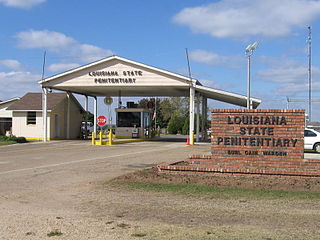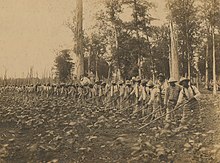
A chain gang or road gang is a group of prisoners chained together to perform menial or physically challenging work as a form of punishment. Such punishment might include repairing buildings, building roads, or clearing land. The system was notably used in the convict era of Australia and in the Southern United States. By 1955 it had largely been phased out in the U.S., with Georgia among the last states to abandon the practice. North Carolina continued to use chain gangs into the 1970s. Chain gangs were reintroduced by a few states during the "get tough on crime" 1990s: in 1995 Alabama was the first state to revive them. The experiment ended after about one year in all states except Arizona, where in Maricopa County inmates can still volunteer for a chain gang to earn credit toward a high school diploma or avoid disciplinary lockdowns for rule infractions.

The Mississippi Department of Corrections (MDOC) is a state agency of Mississippi that operates prisons. It has its headquarters in Jackson. As of 2020 Burl Cain is the commissioner.

The Arkansas Department of Corrections (DOC), formerly the Arkansas Department of Correction, is the state law enforcement agency that oversees inmates and operates state prisons within the U.S. state of Arkansas. DOC consists of two divisions, the Arkansas Division of Corrections (ADC) and the Arkansas Division of Community Corrections (DCC), as well as the Arkansas Correctional School District. ADC is responsible for housing and rehabilitating people convicted of crimes by the courts of Arkansas. ADC maintains 20 prison facilities for inmates in 12 counties. DCC is responsible for adult parole and probation and offender reentry.

The Louisiana State Penitentiary is a maximum-security prison farm in Louisiana operated by the Louisiana Department of Public Safety & Corrections. It is named "Angola" after the former slave plantation that occupied this territory. The plantation was named after the country of Angola from which many slaves originated before arriving in Louisiana.
Holt v. Sarver was a court decision that was the first in a series of American common law cases that have found entire state prison systems in violation of prisoners' constitutional rights by inflicting cruel and unusual punishment.

Mississippi State Penitentiary (MSP), also known as Parchman Farm, is a maximum-security prison farm located in unincorporated Sunflower County, Mississippi, in the Mississippi Delta region. Occupying about 28 square miles (73 km2) of land, Parchman is the only maximum security prison for men in the state of Mississippi, and is the state's oldest prison.

A super-maximum security (supermax) or administrative maximum (ADX) prison is a "control-unit" prison, or a unit within prisons, which represents the most secure levels of custody in the prison systems of certain countries.

A prison farm is a large correctional facility where penal labor convicts are forced to work on a farm legally and illegally, usually for manual labor, largely in the open air, such as in agriculture, logging, quarrying, and mining as well as many others. All of this forced labor has been given the right from the thirteenth amendment in the United States, however other parts of the world have made penal labor illegal. The concepts of prison farm and labor camp overlap with the idea that they are forced to work. The historical equivalent on a very large scale was called a penal colony.

The Cummins Unit is an Arkansas Department of Corrections prison in unincorporated Lincoln County, Arkansas, United States, in the Arkansas Delta region. It is located along U.S. Route 65, near Grady, Gould, and Varner, 28 miles (45 km) south of Pine Bluff, and 60 miles (97 km) southeast of Little Rock.

Convict leasing was a system of forced penal labor which was historically practiced in the Southern United States and overwhelmingly involved African-American men. Recently, a form of the practice has been instituted in the Western United States. In the earlier forms of the practice, convict leasing provided prisoner labor to private parties, such as plantation owners and corporations. The lessee was responsible for feeding, clothing, and housing the prisoners.

Gates v. Collier, 501 F.2d 1291, was a landmark decision of the Fifth Circuit Court of Appeals that brought an end to the trusty system as well as flagrant inmate abuse at Mississippi State Penitentiary, also known as Parchman Farm, in Sunflower County, Mississippi. It was the first case in a body of law developed in the Fifth Circuit Court of Appeals holding that a variety of forms of corporal punishment against prisoners constituted cruel and unusual punishment and a violation of Eighth Amendment rights. This case was also the first broad-scale intervention by a court in the supervision of prison practices.

Nathan Burl Cain is the commissioner of the Mississippi Department of Corrections and the former warden at the Louisiana State Penitentiary at Angola in West Feliciana Parish, north of Baton Rouge, Louisiana. He worked there for twenty-one years, from January 1995 until his resignation in 2016.

The Department of Public Safety and Corrections (DPS&C) is a state law enforcement agency responsible for the incarceration of inmates and management of facilities at state prisons within the state of Louisiana. The agency is headquartered in Baton Rouge. The agency comprises two major areas: Public Safety Services and Corrections Services. The secretary, who is appointed by the governor of Louisiana, serves as the department's chief executive officer. The Corrections Services deputy secretary, undersecretary, and assistant secretaries for the Office of Adult Services and the Office of Youth Development report directly to the secretary. Headquarters administration consists of centralized divisions that support the management and operations of the adult and juvenile institutions, adult and juvenile probation and parole district offices, and all other services provided by the department.
William Colbert Keady was a United States district judge of the United States District Court for the Northern District of Mississippi. He is best-known for his role in the landmark court case, Gates v. Collier.
Ruiz v. Estelle, 503 F. Supp. 1265, filed in United States District Court for the Southern District of Texas, eventually became the most far-reaching lawsuit on the conditions of prison incarceration in American history.

Capital punishment is a legal penalty in the U.S. state of Mississippi.

A prison cemetery is a graveyard reserved for the dead bodies of prisoners. Generally, the remains of inmates who are not claimed by family or friends are interred in prison cemeteries and include convicts executed for capital crimes.

Imprisonment began to replace other forms of criminal punishment in the United States just before the American Revolution, though penal incarceration efforts had been ongoing in England since as early as the 1500s, and prisons in the form of dungeons and various detention facilities had existed as early as the first sovereign states. In colonial times, courts and magistrates would impose punishments including fines, forced labor, public restraint, flogging, maiming, and death, with sheriffs detaining some defendants awaiting trial. The use of confinement as a punishment in itself was originally seen as a more humane alternative to capital and corporal punishment, especially among Quakers in Pennsylvania. Prison building efforts in the United States came in three major waves. The first began during the Jacksonian Era and led to the widespread use of imprisonment and rehabilitative labor as the primary penalty for most crimes in nearly all states by the time of the American Civil War. The second began after the Civil War and gained momentum during the Progressive Era, bringing a number of new mechanisms—such as parole, probation, and indeterminate sentencing—into the mainstream of American penal practice. Finally, since the early 1970s, the United States has engaged in a historically unprecedented expansion of its imprisonment systems at both the federal and state level. Since 1973, the number of incarcerated persons in the United States has increased five-fold. Now, about 2,200,000 people, or 3.2 percent of the adult population, are imprisoned in the United States, and about 7,000,000 are under supervision of some form in the correctional system, including parole and probation. Periods of prison construction and reform produced major changes in the structure of prison systems and their missions, the responsibilities of federal and state agencies for administering and supervising them, as well as the legal and political status of prisoners themselves.

Penal labor in the United States is explicitly allowed by the 13th Amendment of the U.S. Constitution: "Neither slavery nor involuntary servitude, except as a punishment for crime whereof the party shall have been duly convicted, shall exist within the United States, or any place subject to their jurisdiction." Unconvicted detainees awaiting trial cannot be forced to participate in labor programs in prison as this would violate the Thirteenth Amendment.
Hutto v. Finney, 437 U.S. 678 (1978), is a landmark Supreme Court case against the Arkansas Department of Correction. The litigation lasted almost a decade, from 1969 through 1978. It was the first successful lawsuit filed by an inmate against a correctional institution. The case also clarified the Arkansas prison system's unacceptable punitive measures. Hutto v. Finney was a certiorari to the United States Court of Appeals for the Eighth Circuit.














